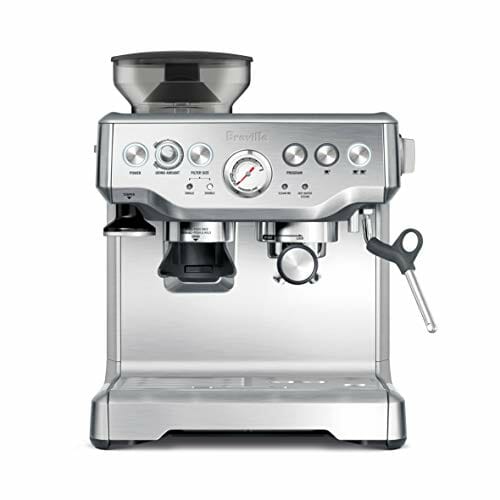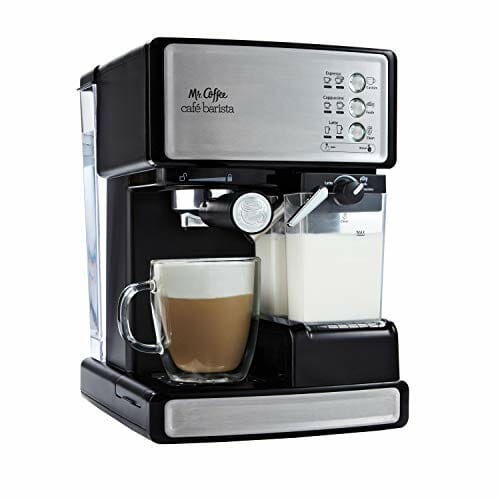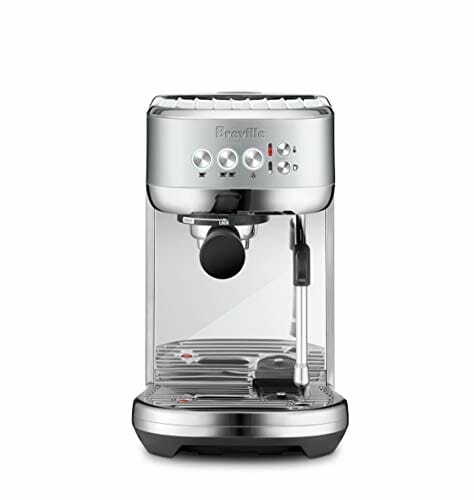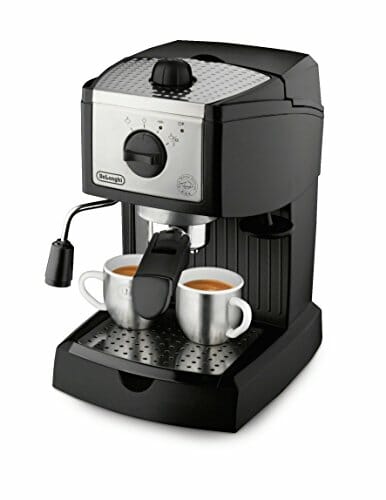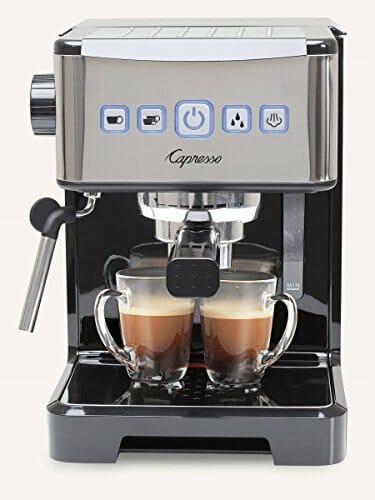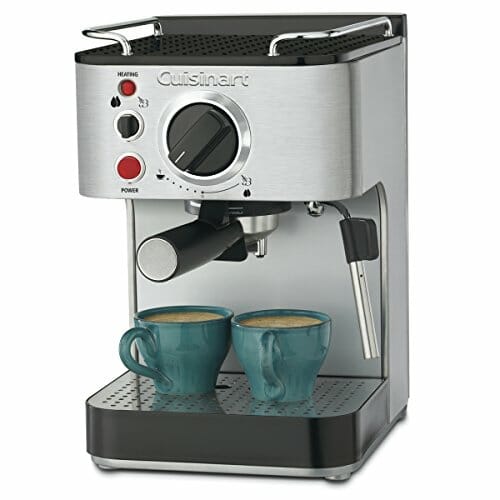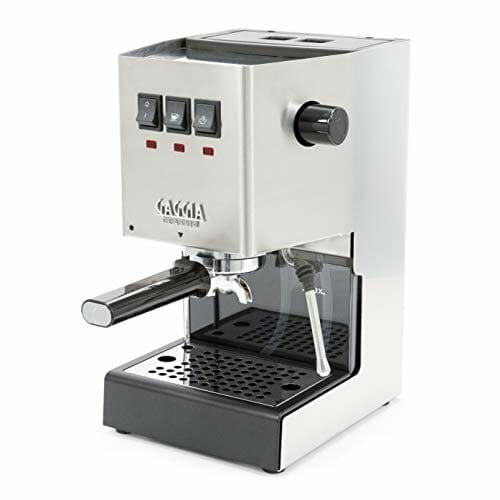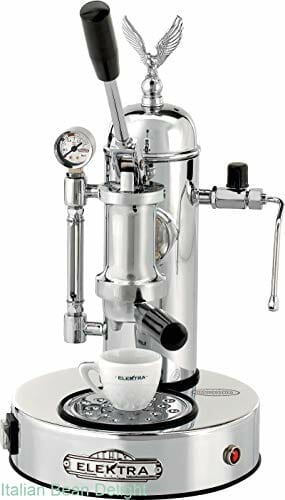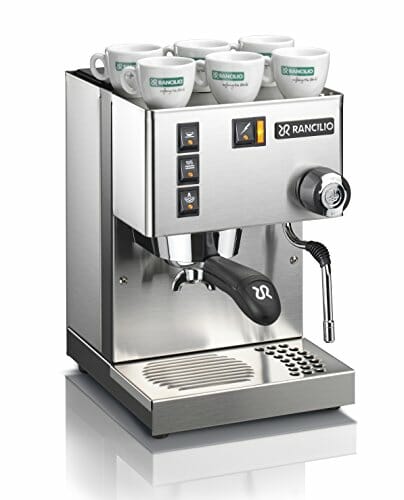
Buying an espresso machine is definitely a next-level step in evolving from the casual coffee drinker to an official espresso aficionado.
It’s also a daunting step considering how many differences there can be between one espresso machine and another.
You’ll need to ask yourself some important questions about how versatile you need your setup to be, plus evaluate other supplies you may need.
In this best espresso machine guide, not only will you learn how to shop and what to look for in the perfect espresso machine, but you’ll also explore how to take care of an espresso machine and which drinks can be made with an espresso machine.
After that, a frequently asked questions section covers everything else you need to know about making espresso for yourself and your friends.
Our Top Espresso Machines: The Coffee Geek Comparison

- Built-in conical grinder
- Intuitive design
- Steam wand produces excellent microfoam milk texture

- Adjustable temperature steam wand
- Low pressure pre-infusion phase
- Auto-purge recalibrates for next shot
1. Breville BES870XL Barista Express (Coffee Geek’s Choice)
Precise measurements are key when it comes to extracting shots of espresso at home — and this cappuccino maker lets you monitor everything from the size of the grind to the bars of pressure used in each pull.
The only thing that isn’t built into this powerhouse of an espresso maker is the coffee beans and milk you need for the perfect latte.
VERDICT: Top Overall Pick
This espresso machine has everything you need to master latte art, whip up a frothy cappuccino or brew shot after shot of crema-capped espresso. We rate it as one of the best espresso machines money can buy.
2. Mr. Coffee Cafe Barista Espresso And Cappuccino Maker
The Mr. Coffee brand has a well-earned place in the world of automatic machines and this foray into the world of at-home espresso and cappuccino makers is no different.
Easy to use and simple to set up for each shot, you’ll find yourself planning dinner parties just for the excuse to experiment with making different types of espresso drinks
VERDICT: Top Pick for Versatility
The unique built-in milk pitcher takes all the guesswork out of frothing milk for any variety of espresso drinks that call for a measure of steamed milk and foamy topping.
3. Breville Bambino Plus
The reliable Breville technology inside this petite espresso maker offers precision temperature control and a consistent extraction time.
You can choose between a single or double-shot pull with the touch of a button, plus adjust the temperature of the water and steam manually.
VERDICT: Best Retro Coffee Shop Style
This espresso machine would look right at home in an old-fashioned diner, but its finely-tuned modern components back a big punch in such a little package.
4. DeLonghi EC155 15 Bar Pump
As a brand known for authentic quality in the realm of at-home coffee makers and accessories, it’s no surprise DeLonghi has a compact espresso machine in its arsenal of offerings.
It’s a true scientific feat to promise 15 bars of pressure with a cappuccino maker that takes up so little space, but you can expect nothing less from this well-respected manufacturer.
VERDICT: Perfect for Small Kitchens
Sacrificing on size sometimes means you’re giving up a lot in quality and precision — but that’s not the case with the well-respected DeLonghi brand and its EC155 model.
5. Capresso Ultima Pro
Brightly backlit buttons with simple icons make it easy to see what you’re doing even if you’re just getting the first brew of the day started before the lights are all on.
Inside the machine, stainless steel lining maintains the optimal temperature needed for this espresso maker to pump out a single or double shot of espresso within seconds.
VERDICT: Perfect for Small Kitchens
Sacrificing on size sometimes means you’re giving up a lot in quality and precision — but that’s not the case with the well-respected DeLonghi brand and its EC155 model.
6. Cuisinart EM-100
Treat yourself to a proper barista-style station in miniature with this Cuisinart model.
The EM-100 replicates all the bells and whistles of a commercial unit, including a warming plate up top with rails to keep your demitasse cups safe while they heat up.
You can simplify your setup with this espresso maker by using pods instead of loose grounds.
VERDICT: Top Pick for Streamlined Style
Simple to use and easy to fit into any kitchen decor whether you’re at home or the office breakroom, the Cuisinart EM-100 comes from a brand known for building quality kitchen gadgets.
7. Gaggia Classic Pro Semi-Automatic
With the push of a few clearly labeled buttons, the Gaggia Classic Pro comes to life to pull you a perfect shot of espresso with as little fuss and fiddling as possible.
Although this unit doesn’t take up much space on the counter, it’s tall enough to house a water tank that’s more generous than some of its larger competitors on the market.
VERDICT: Best for Multiple Espresso Shots
The large reservoir on the Gaggia Classic makes it easy to keep brewing shot after shot of espresso, which comes in handy if you’re serving up after-dinner drinks to a party of friends.
8. Elektra S1C Microcasa a Leva Espresso Machine
It’s already easy to feel like a scientist when you’re in pursuit of the perfect shot of espresso, but this manual lever-style espresso maker will have you looking like a mad scientist, too.
There’s a bigger learning curve when using an espresso maker like the Elektra Microcasa, but once you master it, the results are hard to beat.
VERDICT: Top Manual Espresso Machine
While this isn’t the machine to buy as a beginner, it makes for a great statement piece in the kitchen of a practiced at-home barista.
9. Rancilio Silvia Espresso Machine
Commercial-grade components in a retail model made for at-home baristas is a hard bargain to beat, which is why the Rancilio Silvia earns a place on this best espresso machines list.
The attention to detail this manufacturer is known for shines here — ergonomic handles and knobs, a generously sized cup warmer and a safety grip on the steam wand are just a few examples of the thoughtful design informing this espresso maker.
VERDICT: Great for Cappuccino Lovers
The classic style of the Rancilio Silvia is perfect for brewing up a strong cappuccino with milk steamed to a perfect temperature and topped with the traditional cap of dry foam.
10. Nespresso Pixie Espresso Maker
Not everyone who loves espresso-style coffee can manage to make space for a pressurized machine and steam wand combination.
The Nespresso Pixie answers the demand for something stripped down to the basics that don’t require a lot of the extra accessories and work of a proper espresso machine.
VERDICT: Best For Starter Kit
Purists might not find the Pixie suits their tastes perfectly, but it’s a great way to get started with enjoying espresso-style coffee that doesn’t require a steep learning curve for the newbie coffee lover.
11. WACACO Nanopresso Portable Espresso Maker Combos
Like the Nespresso Pixie, Wacaco’s NanoPresso goes against the grain of conventional espresso machine design.
That’s to the advantage of the espresso enthusiast who is more on-the-go than stay-at-home.
Piston-powered pressure moves hot water through the internal portafilter, producing a rich shot of espresso without any battery or plug-in required.
The beauty of this combo pack is you can the pod adaptor for easy espressos and cleaning!
I personally use this espresso maker on my multi-day motorcycle tours.
VERDICT: Most Travel-Friendly Pick
Camp in style with the NanoPresso — you can have cafe-style coffee in the blink of an eye with this handy gadget, no power cords or pressurized reservoirs are needed.
How To Pick The Best Espresso Machine for Your Home Or Office?
Finding the best espresso machine that meets your needs requires evaluating your current preferences and what kind of setup you plan to have for your espresso station in the home or office.
What kind of espresso drinks do you want to make?
Knowing what kind of espresso drinks you plan to make will help you determine how many extra features you need or don’t need on your new espresso machine.
If your idea of a perfect shot of espresso doesn’t involve any milk or the need to make multiple shots at once, then you would do well to find a basic machine that may or may not have a steam wand attachment.
However, if you want to be able to experiment with different types of espresso drinks and latte art, then you’ll want to choose an espresso and cappuccino maker that includes a steam wand that performs very well.
The defining difference between plain espresso and cappuccino is all in the addition of steamed milk and a frothy cap. Other espresso drinks are just variations on the ratio of espresso, milk, and froth.
Can you hook a water line to the espresso machine directly?
Some espresso machines are designed to work with a dedicated water line that keeps the reservoir full.
This helps maintain a consistent amount of pressure when the machine is on, which allows you to pull shot after shot without waiting for everything to heat up.
Most at-home setups aren’t capable of dedicating a water line without some remodeling, however, so many retail espresso machines are made to work without it.
This does require frequent manual refilling of the reservoir and failing to keep it full can result in poorly extracted shots.
Do you have a coffee grinder with a fine grind setting?
Espresso machines require finely ground coffee in order to brew espresso shots accurately. The grind size should also be consistent throughout.
This can be very difficult to achieve with manual grinders or electric grinders that use a blade instead of a burr component.
Your best solution to achieving a consistent, fine grind is to find a conical burr grinder. The burrs are often made of steel or ceramic.
Coffee enthusiasts praise conical ceramic burrs as superior in quality to those made of steel, but ceramic burrs may need to be replaced more often than steel.
Check out our article here for espresso machines under $200.
How To Make An Espresso Shot?
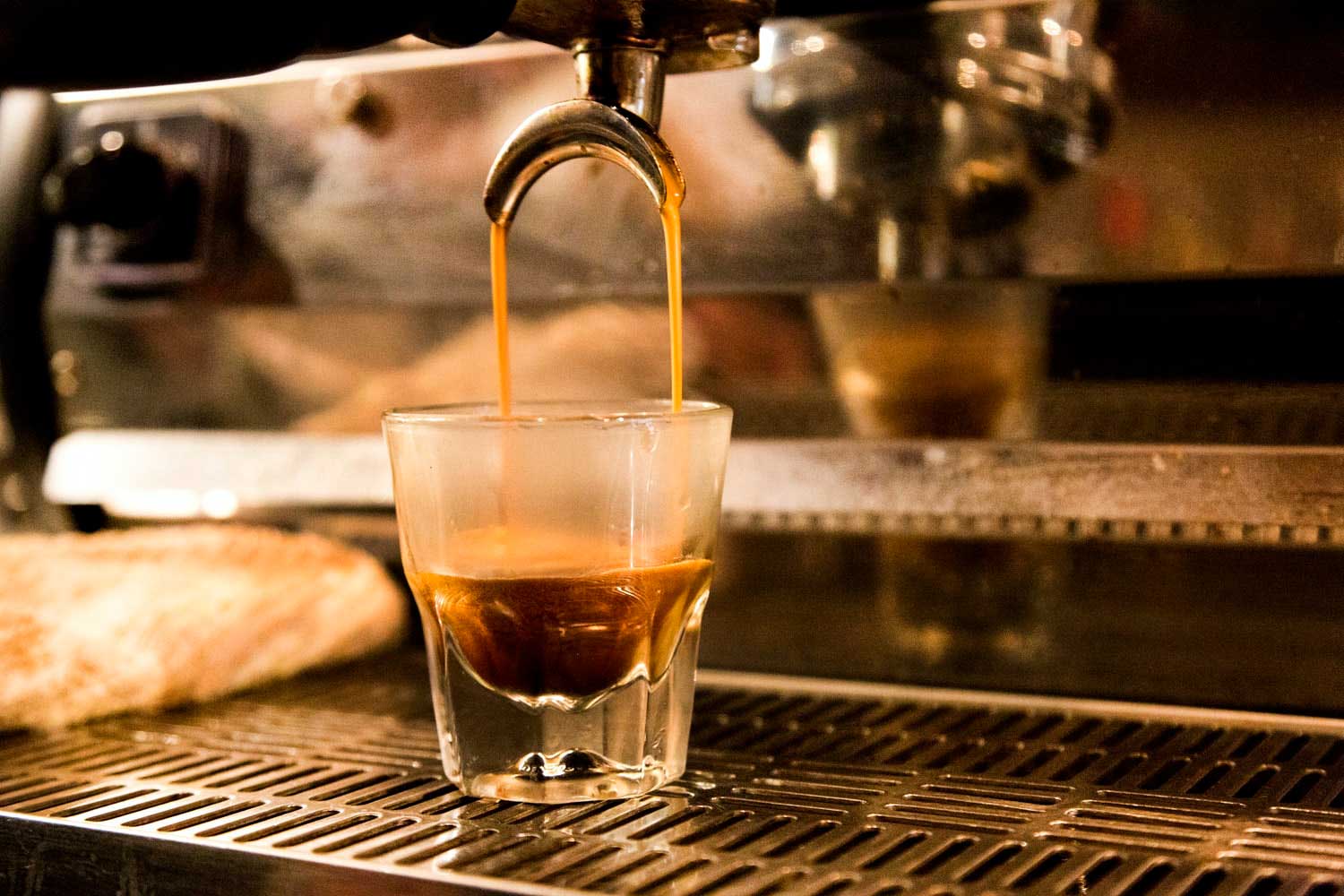
There’s no small amount of science behind the ability to pull a perfect shot of espresso, but you don’t need years of practice to master these skills.
Knowing what to look for and how it should taste in the end will help you figure it all out in no time.[1]
Start with 14-16 grams of fresh and finely ground dark roast coffee for 1.5 ounce shot. If you’re interested in other types of roasts, check the FAQ for why a dark roast is often preferred.
Pack the portafilter by applying 30 pounds of pressure. You can use a kitchen scale to help you get a feel for how hard you press down to equal 30 pounds of pressure.
Brush any loose particles off of the rim of the portafilter before securing it in place on the espresso machine.
An improper fit can result in a loss of pressure and a big mess! [2]Place a small cup or demitasse beneath the portafilter before you pull the shot.
Start the extraction according to your machine’s design. The perfect shot of espresso happens when the bars of pressure put out by the espresso machine is just a bit more forceful than the resistance the tightly packed coffee grounds gives it.
If the grounds are too tightly packed, very little coffee can be extracted and you’ll come up short on the shot.
If the grounds are too loosely packed, the steam will pass through too quickly and you’ll have a thin, watery result.
When the grounds are packed just right and the machine achieves the perfect balance of pressure to resistance, the extraction starts with a slow drip that turns into a steady stream which should last about 30 seconds.
You’ll see the stream of coffee turn from a blondish yellow foam to a thick, rich brown.
Once finished, the crema, or that ruddy blonde foam, will sit like a cap on top of the espresso’s surface.
Now that you know how to extract espresso like a pro, it’s time to put those skills to use by learning how espresso becomes any one of the following favorite drinks.
The key to making the shot reproducible is you want the particles just large enough that the flow is uniform and predictable, but as small as they can be to maximize the surface area.
Dr. Jamie Foster – Mathematician & Coffee Enthusiast
Popular Espresso Drink Recipes

Whether you like to mix it up when it comes to pouring your own espresso drinks or you want to be able to entertain a guest list with varying tastes, knowing the subtle but important differences between the most popular espresso drinks will help you look like a real pro.[3]
Cappuccino
Named after a sect of Franciscan monks due to the way the frothy milk “cap” resembled the hoods of their dark brown robes, the cappuccino has become synonymous with the ultimate coffee shop experience.
Traditionalists describe the ratios of a cappuccino as one part espresso, one part steamed milk and one part dry, fluffy foam. A sprinkle of cinnamon on top is also common.
Cafe Latte
The latte came about in the 1950s, when American customers who tried cappuccinos asked for drinks that had a milder balance between espresso and milk.
The typical latte, when served hot, calls for a quarter-inch of foam in proportion to the amount of espresso and milk used.
Later on in the evolution of coffee culture, flavored syrups became popular additions as did putting it on ice.
Cafe Mocha
Although this drink uses the same ratios as a latte, the mocha became so popular that it’s often given its own place on a coffee shop menu rather than included as a flavoring option beneath the regular latte.
Coffee shops often top a mocha, whether it’s served hot or cold, with whipped cream instead of milk froth.
Macchiato
Roughly translated, macchiato means ‘marked coffee’. This drink is just a shot or two of espresso that’s topped with a dollop of milk froth.
It’s a favorite of those who want all the bold flavor of an espresso shot, just made a little smoother with the addition of the tiniest bit of milk.
Americano
Much like the latte, the Americano became a popular way to drink espresso in a way that mellowed the bold flavor of a straight shot.
This drink, however, does not come served with any milk. Instead, the espresso is extracted as it normally would be, then water is added according to individual preference. It can be served hot or iced.
Breve
Most espresso drinks that feature steamed milk or frothy topping will be made with whole milk unless otherwise specified.
A breve is a pretty specific espresso drink, however, because it calls for the use of half-and-half instead of any other kind of milk.
Half-and-half, a popular creamer for regular coffee drinkers, is made by mixing — you guessed it — one part whole cream with one part whole milk.
Steamed half-and-half produces a richer, sweeter cappuccino or latte whose foam is dense and thick. Served iced, it’s a creamy treat.
Red Eye
Whether it’s hot or iced, the red eye is just a normal cup of drip-brew coffee with a shot of espresso added to it.
It packs a bolder punch than the Americano and it’s a favorite order for those who are desperate for a caffeine fix without needing to drink several cups of espresso and coffee to get it.
Cortado
The line between cappuccino and latte is blurred by the cortado and its cousin just below, the flat white.
A cortado is just an equal ratio of espresso to steamed milk, unless it’s served iced and therefore requires no steaming to the milk. There is no foam topping like with other espresso drinks served with steamed milk.
Flat White
Popularized in Australia, the flat white is sometimes called a wet cappuccino. The ratio of espresso to milk is a little closer to that of a latte depending on where it’s ordered.
The real trick of a flat white is steaming the milk so that it creates a dense froth often called microfoam.
Because the microfoam plays an integral role in the definition of a flat white, an iced latte is the closest you get if you want a drink like this served cold.
Frappe
Frozen coffee drinks can sometimes get a bad reputation among the coffee elite, but they’re a great way to use up imperfectly extracted shots or extra shots that you don’t want to go to waste.
The frappe is nothing more than an espresso-flavored milkshake, so you’re free to experiment with ingredients as you see fit.
You do need a blender in order to achieve that signature milkshake quality, however.
Espresso is a culinary art because it allows you to enjoy the full fragrance potential of roasted coffee.
David C. Schomer – Industry Expert & Innovator
How To Clean An Espresso Machine: Step-by-Step Cleaning Guide
The key to keeping any espresso machine working good as new is upholding proper cleaning and maintenance standards.
Build-up from coffee and the minerals from the water you use can degrade the quality of the shots you pull, so keep track of how often you use your espresso machine and plan to clean it regularly to keep everything running smoothly and tasting great. [4]
Supplies You May Need:
- Machine-safe cleaning solution
- Descaling solution
- Blind portafilter
- Nylon brush
- Wire straw brush
- Kitchen towels
- Cups to soak components or catch overflow
- Appropriate tools for removing any detachable parts of the machine.
STEP 1:
Remove portafilters and take out basket inserts.
Using your cleanser of choice, soak the perforated baskets used for pulling shots and scrub the portafilters to get rid of any build-up.
STEP 2:
Using the nylon brush, scrub the gasket, which is the opening where the portafilter fits into for pulling a shot.
This will loosen up any buildup that comes off easily.
Some machines may let you run the water as if you’re pulling a shot while you clean this piece, but be careful because it’s hot!
STEP3:
If your machine manual instructs you on how to safely remove the gasket head, you can do so in order to scrub those components more thoroughly.
STEP 4:
With the gasket head intact or reassembled, place a blind basket, or a basket with no holes, into the portafilter so that you can perform a backwash — while this is a common way to clean most espresso machines, check the manual for yours to make sure this is recommended by its manufacturer.
STEP 5:
With the blind basket and portafilter thoroughly locked into place, proceed as if you’re pulling a shot of espresso. Allow it to run a backwash for about 12 seconds.
STEP 6:
Remove portafilter and dump the water out, then repeat if necessary.
If there are no loose grounds in the water after a backwash, the gasket head is cleaned properly.
STEP 7:
Using a kitchen towel soaked with machine-safe cleaning solution, proceed to wipe down all exterior components, which may include removing the drip tray.
If necessary, soak the drip tray to break down any tough build-up.
STEP 8:
If your machine has a steam wand, check to see which components can be disassembled and soaked.
Otherwise, fill a pitcher with hot water and cleanser in order to stick the wand in it for a soak.
STEP 9:Use the wire straw brush to clean inside the steam wand if possible.
Once the machine is reassembled, rinse the steam wand by allowing steam to run through for a few seconds.
STEP 10:
If your machine’s manual shows that it’s safe to do so, use a descaling solution in your machine’s reservoir to help break up any mineral build-up from your water.
If your machine advises against descaling solutions, you can prevent build-up by using filtered water.
STEP 11:
During descaling, run the machine as you normally would when extracting espresso, minus using any actual espresso, until the reservoir is empty.
Run it once more with fresh water until the reservoir is empty again, then repeat if you feel it’s necessary.
It may take you some time to get used to the cleaning process, but once you do, it will go by quickly and easily.
It can also help to keep all your supplies together and store them close to your machine to save even more time when you need to clean it.
Frequently Asked Questions
Now that you’ve learned all the ins and outs of shopping for an espresso machine, pulling the perfect shot, making your favorite espresso drinks and how to care for your espresso machine so that it lasts, it’s time to wrap it all up with a few final points.
The answers found below will help you gain a deeper understanding of what makes espresso such a blend of art and science for coffee enthusiasts all over the world.
What makes an espresso machine different from an automatic drip-brewer?
While both machines depend on hot water extraction for their final product, an espresso machine and an automatic drip-brewer achieve their results with a few key differences.
Boiling-hot water kicks off the brewing process for both methods, but with espresso, that boiling heat results in a pressurized blast of water that’s forced through fine grinds and out through the tiny perforated cup of a portafilter.
A drip brewer, on the other hand, receives a thin, steady stream of hot water that collects in a basket and releases the brewed coffee through a single hole at the bottom.
Extraction with an espresso machine happens within seconds while the drip-brew machine takes minutes.
The volume of coffee either one produces is also vastly different. Depending on the size of the portafilter and the setup of the espresso machine, you may be extracting only one or, at most, two shots of espresso.
A drip-brew machine can be set to brew a small or large amount of coffee at once.
The standard drip-brew machine can manage as few as four or as much as 12 cups of coffee.
The average drip-brew machine is much cheaper than the average espresso machine.
This comes down to the popularity of the automatic drip-brewer for at-home use.
Modern machines, like the Keurig, make brewing a cup of coffee even easier with the use of disposable, pre-filled pods that produce single-serving cups of coffee.
Espresso machines require more attention throughout the extraction process and, as such, aren’t as suitable for quick service even though their total extraction time is far less than a drip-brew machine’s.
What variety of coffee bean should I use with my espresso machine?
When it comes to the world of cultivated coffee, there are two main varieties that make up the bulk of bean production:
Arabica and Robusta. Most coffee on the market today is the Arabica variety.
Although Robusta crops are disease-resistant and produce a larger yield, thus leading to lower costs and market prices, the flavor of Arabica is widely regarded as superior.
When you’re at the shop looking for pre-ground or whole bean coffee, you’re unlikely to run into a bag of Robusta — but if you do find you have a choice, most experts would advise you to stick with Arabica.
Is a blend or single origin coffee better for espresso?
Coffee is grown all over the world. The trip from seed to cup sees coffee beans change hands several times.
Typically, the shops brewing coffee aren’t responsible for roasting it, and those who roast the coffee aren’t responsible for growing it.
Coffee roasters may blend beans that have been grown from several different areas in order to achieve a particular taste or market-friendly price point.
Beans roasted for use with espresso machines are often blends rather than single-origin.
This is due to the way the process of pulling espresso shots changes the flavorful components in a coffee bean.
Single-origin coffee beans are prized for certain characteristics in their flavor profiles that extraction with an espresso machine distorts.
Thus, a blended mix of origins produces the familiar taste of a standard espresso shot more reliably.
What type of roast can I use with an espresso machine?
Traditionally, dark roasts are favored for brewing espresso.
Dark roasts produce less acidity in the final product, so a bold espresso shot benefits from the deeper, more caramelized complexities of a deeply roasted bean.
When you’re shopping for coffee to use with your espresso machine, you may encounter several different types of dark roast. [5]
Many brands make it simple for you and label their darker roasts as Espresso or even Italian to signify they’re appropriate for use with an espresso machine.
However, many enterprising coffee enthusiasts are known to experiment with non-traditional roasts, such as a light or medium, in an effort to see if the extraction process of an espresso machine reveals anything new or interesting in their flavor profiles.
If you want to pull shots that taste like your favorite coffee shop, though, you should stick with a dark roast.
Can I use preground coffee with an espresso machine?
As long as the coffee is labeled as a finely ground or specifically called an espresso grind, then yes, you can technically use preground coffee with your espresso machine.
Medium-to-coarse grinds may not do any damage to an espresso machine, but they certainly won’t produce a shot of espresso that tastes good even if they are a dark roast.
The only trouble you’re likely to run into with using preground coffee for espresso machines is the fact that coffee ground just before brewing will always yield a better flavor than coffee that’s been ground and stored for use later on. [6]
What does Over-extracted coffee taste like?
Coffee becomes over-extracted when it’s brewed for longer than it should be, which can happen when the portafilter is packed too tightly.
The pressurized extraction method used by the espresso machine leaves the grounds exposed to steam for too long and, as a result, the shot is over-extracted.
Over-extracted coffee is often described as tasting bitter and hollow or thin. It may also impart a drying sensation in the mouth.
This is because too many of the water-soluble components of coffee wind up in the cup.
What does Under-extracted coffee taste like?
Coffee that suffers from a too-short brewing time yields and underextracted result.
With espresso machines, this can happen if the portafilter is under-filled or if the grind isn’t fine enough.
Steam moves through the puck of espresso too quickly and results in a sour flavor with a quick finish that leaves nothing on the tongue as a pleasant aftertaste.
Simply put, the components of coffee that give it that uniquely satisfying flavor haven’t had enough time to make it into the cup.
Is a pump-powered or steam-powered espresso machine better?
In order to determine which mechanism is better, it’s important to understand how each type of machine works.
A steam-powered espresso machine depends on the use of an airtight water reservoir that is then electrically heated to a boiling point.
The steam created by this increases pressure within the water tank and forces it from the reservoir and through the portafilter to extract a shot of espresso.
By contrast, a pump-powered espresso machine builds pressure with an electric pump mechanism. The pump component may be a vibrating, rotating or geared piece.
Pump-powered espresso machines are favored in most commercial settings because they are able to produce multiple shots in quick succession.
They also tend to be more costly than steam-powered machines. For enthusiasts who are looking for affordable options in the home, they may find steam-powered espresso machines are more in line with their budget and expectations.
If the budget for buying an espresso machine is generous enough, though, a pump-powered machine may be preferred for the consistency it maintains from one shot to the next.
Breville Barista Express
The Best Espresso Machine
I use this machine every day at work, I really love it.
For what you get its great value for money and will last you for years as a robust espresso machine.
I highly recommend it checking out further and considering it as an investment in your regular home espresso coffee-making experience.


